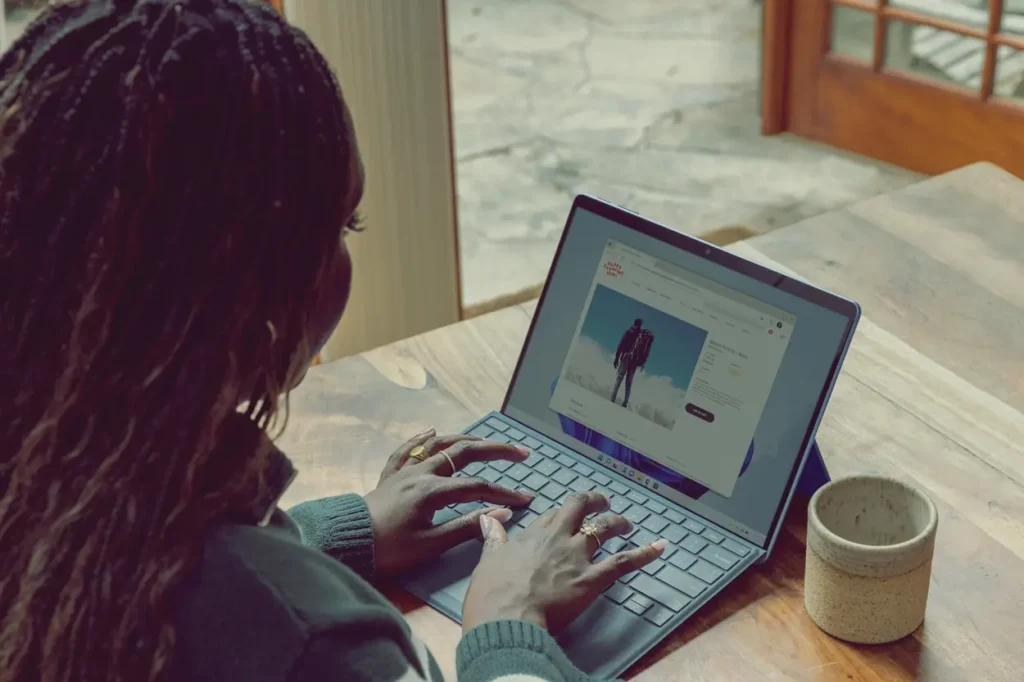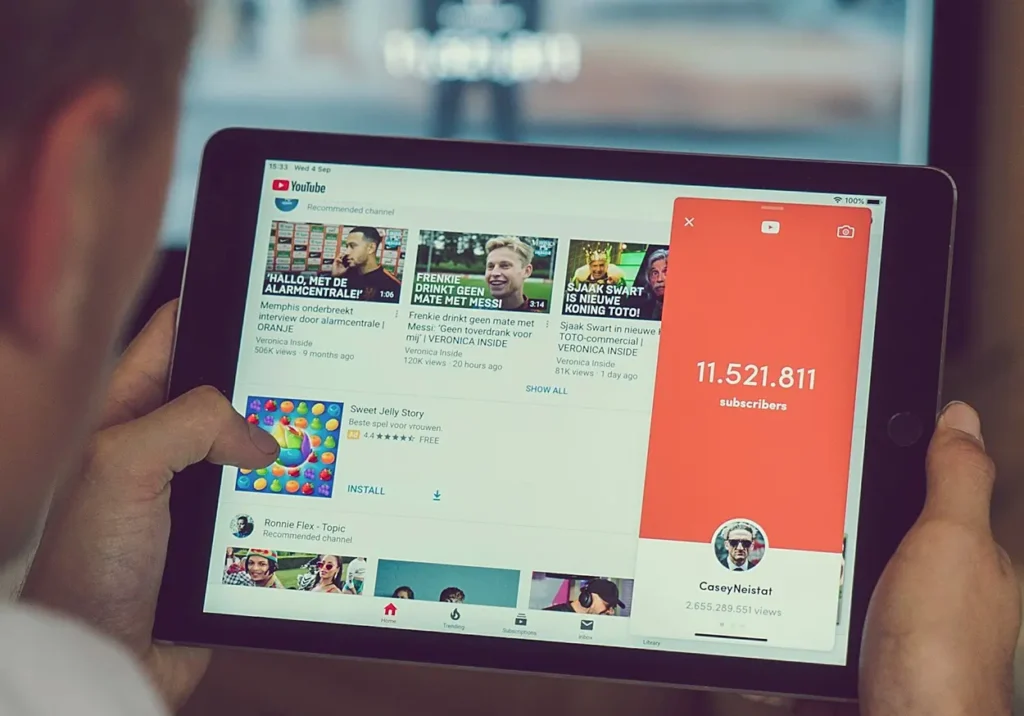Blogging vs Youtube? Two different ways of building an online business but similar in the way that they are a dream many of us share, becoming a digital mogul in something we love. Earning passive income from ads and affiliate links, gaining recognition, making money simply by sharing your passions… it sounds like the perfect life.
It is the dream of millions. Maybe billions… So before diving in, let’s get real for a moment. Whether you choose blogging or YouTube, the harsh truth is this: statistically, most of these ventures don’t go very far. Not because people aren’t talented or passionate but because the digital world is very very crowded.
There are over 1.1 billion websites and more than 114 million YouTube channels out there. For every viral blog post or video, there are thousands sitting in the shadows, beautifully made, with great content, slick editing, crystal-clear audio, and barely a hundred views to show for it.
Think your idea is unique? Odds are, tens of thousands of people have already had it. Found a promising niche? It’s probably been flooded with content already.
But here’s the thing: millions still make it.
We live in a time when teenagers become millionaires, creators travel the world as digital nomads, and everyday people build entire incomes from home.
Yes, most blogs and YouTube channels technically “fail“. But if you’ve got the drive, the willingness to try (and try again), and the patience to play the long game, it’s absolutely worth it.
Now the big question: Which platform should you choose? Blogging or YouTube?
In this article, we’ll break down the pros and cons of each to help you decide which path fits you best.
- Blogging vs Youtube: Monetization Methods
- Blogging vs Youtube: Creating Content
- Blogging vs Youtube: Getting Views
- Blogging vs Youtube: Cost
- Blogging vs Youtube: Audience Engagement
- Blogging vs Youtube: Anonymity
- Blogging vs Youtube: Competition
- Blogging vs Youtube: Effects Of AI
- Summary: Pros & Cons Lists
- Which One Should You Choose In 2025?
Blogging vs Youtube: Which One Makes More Money?
There are many ways to make money from both blogging and vlogging. Some methods favor YouTube content creators, while others work better for bloggers.
Let’s not forget that every monetization method pays the same. We will explain it later but first lets look at popular monetization methods and which favors which.
Advertising Revenue: Favors Both (But Differently)
Both blogs and YouTube can generate solid ad revenue. Blogs typically offer higher earnings per 1,000 views (CPM), especially if you use premium ad networks. However, YouTube makes it easier to get large view counts, especially if you tap into trending topics or Shorts.
In short:
Blogs: higher CPM, but harder to scale traffic.
YouTube: easier to grow an audience, but lower CPM on average.
Affiliate Marketing: Favors Blogs
Affiliate marketing works on both platforms, but it tends to be more effective on blogs.
On a blog, affiliate links are visible and clickable throughout your post. You can list and compare multiple products in a single article. If a post ranks well in search engines, it can bring in passive affiliate income for months or even years.
On YouTube, links are buried in the description or pinned comments, and you need to be more pushy to guide your viewers to them.
However, YouTubers often build stronger personal connections with their audience thanks to their on-screen presence. This can lead to higher trust and better engagement, two important factors in affiliate sales.
In short: Affiliate marketing generally performs better on blogs, but YouTubers with a strong personal brand can also do very very well.
Sponsorships: Favors YouTube
Both bloggers and YouTubers can work with sponsors, but YouTubers tend to have an easier time landing deals and usually earn more per sponsorship.
Why?
- Videos offer visual demonstrations, which most brands prefer.
- YouTube’s algorithm helps creators build audiences faster.
- Viewers trust creators more when they can see and hear them, making influencer marketing more effective.
In short: Sponsorships tend to favor YouTube, especially in niches like tech, fashion, lifestyle, and gaming.
Selling Products or Services: Favors Blogs
When it comes to converting traffic into sales, blogs have the edge. You can design your blog however you like, adding product banners, sidebar widgets, email opt-ins, or embedded links that lead directly to your online store or service page.
On YouTube, it’s harder to direct viewers to external sites. You need to mention your product in the video and hope they check the description box or remember the link. Viewers often come to YouTube for entertainment or education, not shopping.
Email Subscriptions: Favors Blogs
Building an email list is much more natural on a blog. You can add opt-in forms, lead magnets, and pop-ups throughout your site to capture visitors’ emails.
On YouTube, there’s no built-in email subscription option. You have to direct viewers to a separate landing page and convince them to sign up, usually by mentioning it in your video and linking in the description.
Donations: Favors YouTube
YouTube offers built-in features like Super Chat, Super Thanks, and channel memberships that make it easy for fans to support creators directly.
While bloggers can add donation buttons (e.g., PayPal or Buy Me a Coffee), it’s harder to build the kind of emotional connection that drives donations unless you’re a well-known personality in your niche.
Memberships: Favors YouTube
YouTube has a built-in membership feature that allows creators to offer exclusive content, badges, and perks. Video content generally feels more “premium” to audiences, so they’re often more willing to pay for bonus content or behind-the-scenes access.
Bloggers can offer memberships too, but it requires setting up third-party tools and promoting it heavily. Also, people tend to expect free content when it comes to blogs unless the niche is highly specialized.
Becoming a Personal Brand: Favors YouTube
YouTube is one of the best platforms for building a personal brand. Because you’re consistently showing your face, voice, and personality on video, viewers form stronger connections with you. Over time, this can lead to recognition beyond the platform including speaking gigs, brand deals, media features, and appearances.
Compared to bloggers or even influencers on Instagram, TikTok, or Facebook, YouTubers are often seen as more like “traditional celebrities” due to their visibility. This makes it easier to branch out into other income streams like books, online courses, public appearances, and high-profile collaborations.
Which Monetization Method Pays the Most?
There’s no one-size-fits-all answer. Most monetization methods can be lucrative, it really depends on the size and engagement of your audience. That’s why many bloggers and YouTubers diversify their income streams by combining different monetization strategies, such as ads, affiliate marketing, sponsorships, and digital products.
Now, let’s take a look at some pros and cons of YouTube vs blogs.

Blogging vs Youtube : Creating Content Is Generally Easier on Blogs
While starting a YouTube channel is free and only takes a few minutes, building a blog typically requires more upfront effort and cost. You might need to buy a domain, pay for hosting, and possibly hire a web designer or web developer.
That said, when it comes to actually creating content, blogging is often quicker and simpler than making YouTube videos.
With a blog post, you usually:
- Research keywords for SEO,
- Write the content,
- Add 1–2 relevant images,
- And hit publish.
There’s no need to get camera-ready, record, edit footage (which can take hours), or spend time scripting a detailed video. Blog posts are generally easier to produce consistently, which is important since building an audience takes time and success is never guaranteed on either platform.
This time-saving aspect makes blogging a strong option for people looking to grow a digital business while still having time for other pursuits. However, this doesn’t mean blogging is easy. Both blogging and YouTube require effort.
If you’re into short-form content, YouTube Shorts can be a quicker way to create videos but earning a significant income from Shorts alone is much more challenging compared to long-form videos or a monetized blog.
Blogging vs Youtube : It’s Easier to Get Views on YouTube
YouTube is one of the most visited websites in the world, with over 2 billion logged-in users each month. It’s also the second largest search engine after Google. One of the biggest advantages of YouTube is its powerful algorithm, which actively recommends content to viewers even if they’re not subscribed to your channel.
Your videos can show up in related videos, on the homepage, or in the “Up Next” sidebar of other creators’ content. Plus, Google, the biggest search engine, often includes YouTube videos in its search results, especially for how-tos, product reviews, and trending topics. This gives your videos additional exposure beyond just the YouTube platform.
If you consistently create engaging, high-quality content, there’s always the possibility of going viral, sometimes overnight. That kind of reach and discovery potential is much harder to achieve with blog content, especially early on.
Of course, virality isn’t guaranteed, but the built-in discovery features on YouTube can give you a real edge when trying to grow an audience.
It’s Cheaper to Run a Blog
Starting a blog typically involves some upfront costs like purchasing a domain name and paying for web hosting but after that, expenses are very minimal. In many cases, it’s possible to maintain a blog for less than $100 a year.
YouTube, on the other hand, can have higher startup costs if you want professional quality content. A good camera, microphone, lighting, and video editing software can add up quickly. And for certain types of channels like tech reviews, makeup tutorials, or cooking shows you may need to invest in products, ingredients, or props to create engaging videos.
With a blog, you can often cover similar topics just by doing in-depth research and writing quality content. For example, you don’t need to own every product to write a review, you can analyze expert opinions, user reviews, and product specs. And for recipes, you don’t need a fancy kitchen just solid instructions and a few good images.

You Get a More Dedicated Audience on YouTube
YouTube has a built-in subscription system that keeps viewers connected to creators. When someone subscribes to your channel and interacts with your content, the algorithm is more likely to keep showing them your videos.
Blogs don’t usually work the same way. While readers can subscribe to your email list or follow your RSS feed, it’s not nearly as inviting as hitting “Subscribe” on YouTube. Most people won’t bookmark a blog just because they enjoyed one post, deep SEO research will always be necessary.
Anonymity Works Better With Blogging
While anonymity comes with some trade-offs, it can be an advantage for bloggers. You can stay fully or mostly anonymous and still grow a successful blog. All you really need is solid research, writing skills, and consistency.
On YouTube (and platforms like Instagram, TikTok, or Facebook), a lot more personal elements come into play: your voice, your appearance, your charisma, your background, even your accent or age can influence how people perceive and engage with you. It’s a much more social, public and therefore discriminatory experience.
Negative feedback or public mistakes can take a heavier toll when your face and identity are tied to your content. On the other hand, bloggers can typically recover from setbacks more quietly, even rebranding or starting fresh under a new domain.
That said, anonymous YouTube channels do exist and some are hugely successful but they usually require strong storytelling, tight scripting, and excellent editing. And you may miss out on some benefits of personal branding, like deeper audience trust or sponsorships that prefer creators with a public identity.
Both YouTube and Blogging Are Highly Competitive
There’s no getting around it, both platforms are extremely competitive. There are over 100 million YouTube channels and an estimated 600+ million blogs online, with countless creators putting in years of effort.
Blogs face a unique challenge in search engine visibility. Google tends to prioritize well-established, authoritative websites, and often includes YouTube videos in search results before showing independent blog posts. To stand out, bloggers need to be great at SEO and often have to find low-competition, “long-tail” keywords to rank well.
The advantage? Blogging levels the playing field somewhat. Anyone can technically write a better article than a major publication if they’re well-researched and optimized for search.
On YouTube, however, it can be harder to compete. Many top creators have large budgets, sponsorships, teams, and access to exclusive locations or products. Competing with a tech channel that receives products for free, or a travel vlogger flown around the world with a film crew, can feel impossible when you’re just starting out.
YouTube May Be Less Affected by AI
While the future is uncertain, it’s true that AI tools currently have a bigger impact on blogging than on YouTube. AI-written blog content is flooding the internet, making it harder for new or smaller blogs to stand out in search results. Google is constantly updating its algorithms to combat low-quality, auto-generated content, but the competition has definitely intensified.
YouTube, on the other hand, is harder to automate. Creating engaging videos, especially those with human personality, emotion, and creativity, is still something AI struggles with. AI can help with scripting, subtitles, or basic edits, but viewers still crave authentic, human content. So for now, YouTube may be somewhat more resistant to being overrun by AI-generated media.
Summary: YouTube vs. Blogging
YouTube
Pros:
- Easier to gain traffic thanks to YouTube’s algorithm and recommendation system
- More opportunities for sponsorships and brand deals
- Stronger potential for donations, memberships (e.g. Super Thanks, Channel Memberships)
- Higher visibility and fame potential
- Less impacted by AI-generated content (for now)
- Built-in tools for audience engagement and subscriber loyalty
Cons:
- Limited control over monetization rules (subject to YouTube’s policies and algorithm changes)
- Less anonymity—your identity is often tied to your brand
- Content creation is more time-consuming and complex (filming, editing, scripting, etc.)
- Higher cost to improve content (camera gear, microphones, lighting, editing software)
- Appearance, voice, charisma, and other personal traits can significantly impact growth
Blogging
Pros:
- Strong potential for affiliate marketing income
- Easier to sell digital products or services directly
- More control over ad revenue (e.g. via Mediavine, AdThrive, or direct placements)
- Faster and easier to create and publish content
- Low cost to upgrade or improve content over time
- Easier to remain anonymous and focus on the content itself
Cons:
- More effort required to set up a website (domain, hosting, platform, design)
- Harder to gain traffic initially—dependent on SEO and Google’s ranking system
- More negatively affected by AI-generated content saturation in search results
- Harder to build and retain a loyal audience without built-in subscription systems
Blogging vs Youtube: Which One Should You Choose In 2025?
You shouldn’t choose between blogging and YouTube based solely on which platform pays more or delivers faster results. Both have the potential to generate income and build an audience but neither offers instant success.
What really matters is choosing the platform where you are most likely to create high-quality, consistent content. In today’s saturated digital world, it’s not about being the first it’s about being better, more valuable, and more unique than the rest.
The Best Choice? Do Both, Eventually.
In 2025, if you’re serious about growing an online business, the ideal approach is to be present on multiple platforms. That means:
- Starting a blog
- Launching a YouTube channel
- Sharing this content also on Instagram, Facebook, TikTok, and beyond
This multi-platform strategy helps you reach more people and builds resilience against algorithm changes on any one site.
That said, managing both a blog and a YouTube channel at the same time can be overwhelming. That’s why this guide focuses on helping you decide which platform to start with based on your strengths, resources, and content style.
Once you’ve mastered one, adding the other becomes much more manageable and far more powerful.



